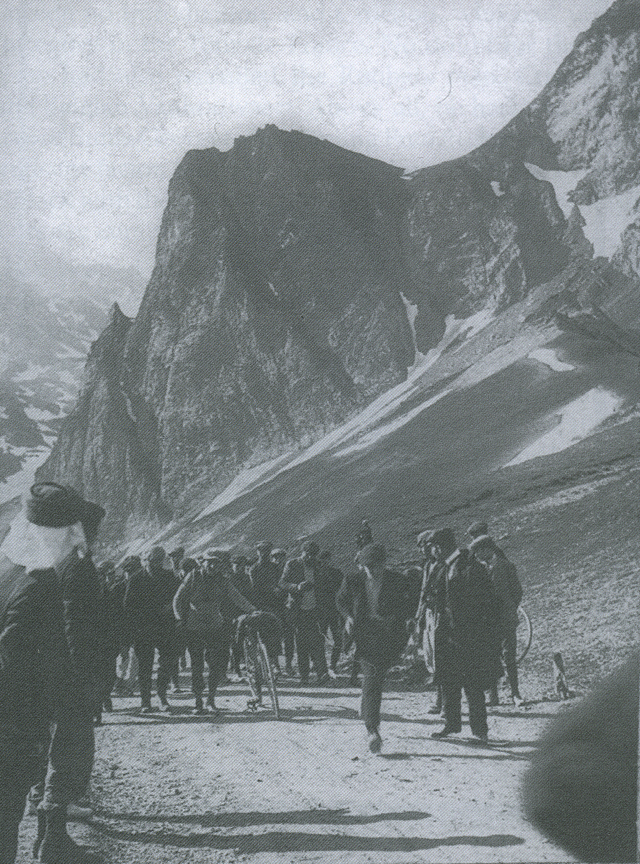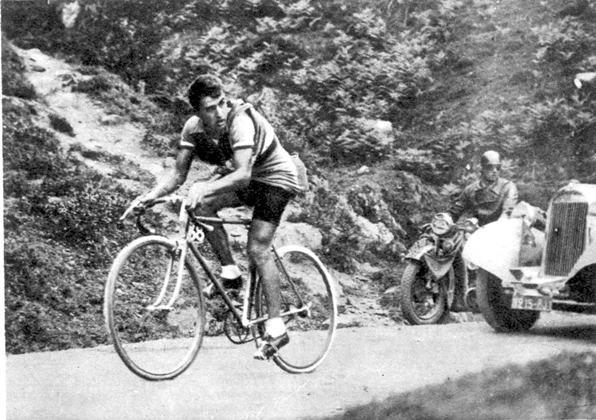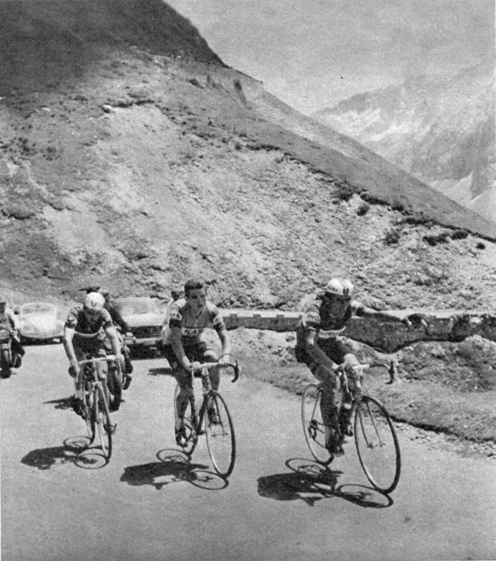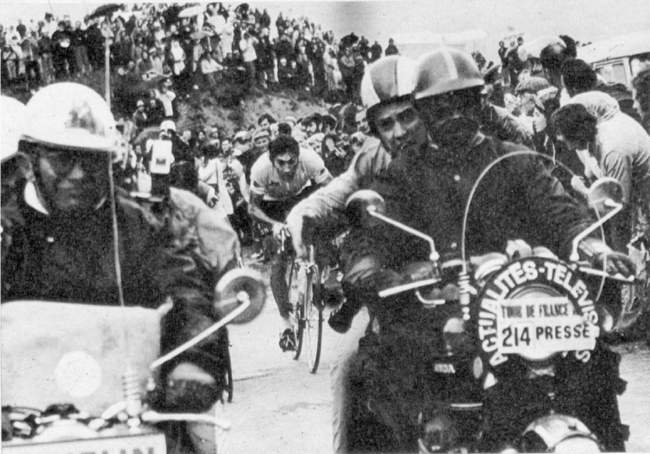Col du Tourmalet
Its cycling history, statistics, photos and map
Statistics | History | Tourmalet climb explained | Photos | Map |
Back to KOM French climbs | Back to KOM index page

The roughly east-west road over the Col du Tourmalet is the Tour de France's favorite high pass, having been included more than 80 times. It is situated in the central Pyrenees (between France and Spain) in the French department of Hautes-Pyrénées.
The Vuelta a España has also included the Tourmalet from time to time.
At the top of the Tourmalet is a monument to Octave Lapize and a bust of Jacques Goddet, Tour de France boss from 1937 to 1987.
Climbing from from the west, Luz-Saint-Sauveur, through Barèges:
Average gradient: 7.7%
Maximum gradient: 10.2%
Length of climb: 18.2 km
Elevation at start: 711 meters
Elevation at crest: 2,115 meters
Elevation gain: 1,404 meters
Climbing from the town of Sainte-Marie-de-Campan:
Average gradient: 7.4%
Maximum gradient: 10%
Length of climb: 17.2 km
Elevation at start: 847 meters
Elevation at crest: 2,115 meters
Elevation gain: 1,268 meters

Col du Tourmalet history in the Tour de France:
In 1910 Tour boss Henri Desgrange was badgered by assistant Alphonse Steinès into sending the Tour de France over high mountains for the time. The centerpiece of this climbing revolution would be a day in the Pyrenees that would include ascents of the Peyresourde, Aspin, Tourmalet, Aubisque and Osquich. Journalists who doubted the riders could perform the inhuman task labeled the day's 326 km stage the "circle of death". Octave Lapize won the stage but as he walked his bike up the Aubisque he called the Tour officials "murderers" [Vous êtes des assassins! Oui, des assassins!] for inflicting such an arduous race on the riders.
The Tourmalet has played a big part in Tour history, perhaps most famously in 1913. That year Eugène Christophe was the virtual yellow jersey when he broke his fork while riding the Tourmalet. Tour rules said he had to perform his own repair. He carried his bike down the mountain to a blacksmith shop in St.-Marie-de-Campan and made the repair. His bike fixed, Christophe resumed racing, but the hours lost meant he had no chance of winning the Tour.
The Tourmalet is rarely used for a hilltop finish in the Tour. Several times the La Mongie ski station partway up the Tourmalet's east face has been the site of a stage finishes.
Our mountains expert, Larry Theobald of CycleItalia, explains the climb:
After years of reading about it and gazing at photos in magazines like Winning or Velo from France, I first laid eyes on the famous pass in 1988. We climbed what I believe is the classic side, from St.-Marie-de-Campan, the famous scene of Christophe and his broken bike. The grade's not too tough for the first few kilometers and I remember thinking "17 kilometers of this will not be so hard, why is this thing so legendary?" I found out about halfway up when the grades went up near 9%...and stayed there, with the last two before the ski station of La Mongie at over 9%. At this point you get a bit of respite, though the angle of the buildings in the ski town remind you of the steepness even as your legs tell you it's slacked off a bit. The final two kilometers kick back up to just shy of 10%, making that summit seem very far away. It's a whale of a descent down into Luz- Sainte-Sauveur as anyone who has watched video of LeTour racers careening down can attest, especially the first couple of kilometers as they're just as steep as the last two on the ascent.
I was fortunate enough to climb this again in 1990 from the same side and from Luz-Sainte-Sauveur in 1998. The climb from this side is much easier, with only one steep pitch before the final, almost 10% bits near the top. Nowadays both sides feature handy signposts with the distances and grades marked on them, but if it's a hot and sticky day in July, sometimes you'd rather not know what's coming and just tough it out, as they did back in the days of Eugène Christophe.
Octave Lapize walking his bike up the Tourmalet in stage 10 of the 1910 Tour de France.

Still stage 10 of the 1910 Tour de France: Lapize reaches the Tourmalet's summit.

1913 Tour de France: Eventual overall winner Philippe Thys descends the Tourmalet.

Stage 10 of the 1926 Tour de France: In hellish weather, Lucien Buysse is making his way up the Tourmalet. That day he earned a spectacular stage win that gave him the lead for good.

Antonin Magne descends the Tourmalet in stage nine of the 1930 Tour de France. Alfredo Binda won the stage and André Leducq won the Tour.

Belgian rider Jef Demuysere at the crest of the Tourmalet in stage nine of the 1931 Tour de France

French climbing whiz René Vietto on the Toumalet in stage 18 of the 1934 Tour. Note he is riding a single-speed bike as the rules dictated at the time.
 Stand back! Let a real bike rider through. Fausto Coppi on the Tourmalet in stage 12 of the 1949 Tour de France.
Stand back! Let a real bike rider through. Fausto Coppi on the Tourmalet in stage 12 of the 1949 Tour de France.

Ferdy Kübler attacks on the Tourmalet in stage 12 of the 1950 Tour.

1951 Tour, stage 14: Fausto Coppi leads Raphaël Géminiani and Hugo Koblet up the Toumalet.

1961 Tour, stage 17: Jacques Anquetil (center) is in control on the Toumalet.

Gianni Motta, Raymond Poulidor and Felice Gimondi climb the Tourmalet in stage nine of the 1965 Tour.

Silvano Schiavon leads Aurelio Gonzales and Raymond Poulidor up the Tourmalet in 1968.

Julio Jiménez was first to the top of the Toumalet in stage 16 of the 1976 Tour de France.

Stage 8 of the 1972 Tour de France: Jos de Schoenmaker leads Eddy Merckx, Luis Ocaña, Raymond Poulidor and Bernard Thévenet up the Tourmalet. Raymond Delisle is hidden behind Ocaña.

Gonzalo Aja is three kilometers from the crest of the Tourmalet in stage 18 of the 1974 Tour.

Coming through, here comes Eddy Merckx, also in stage 18 of the 1974 Tour.

Carlos Barredo and Lance Armstrong lead the winning break up the Tourmalet in stage 16 of the 2010 Tour de France.

Another shot of the break on the Tourmalet in stage 16 of the 2010 Tour.

Octave Lapize memorial at the top of the Tourmalet

Map of the Col du Tourmalet. Luz-Saint-Saveur is in the lower left corner. Sainte-Marie-de-Campan is in the upper right-hand corner. The city of Tarbes (not on the map) is due north.
Back to KOM French climbs | Back to KOM index page







